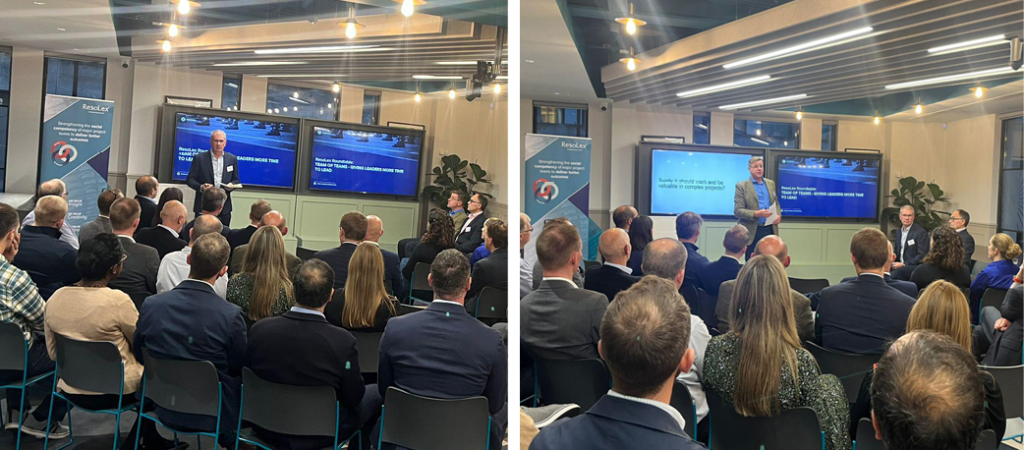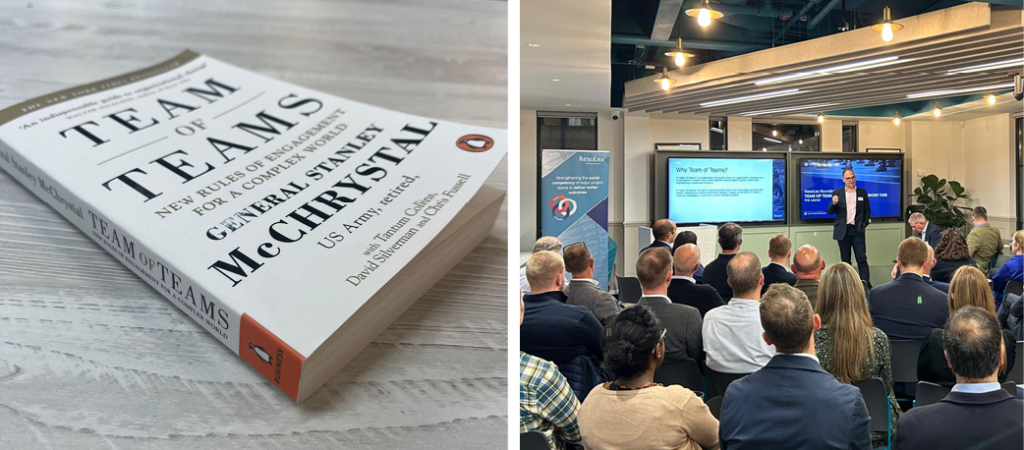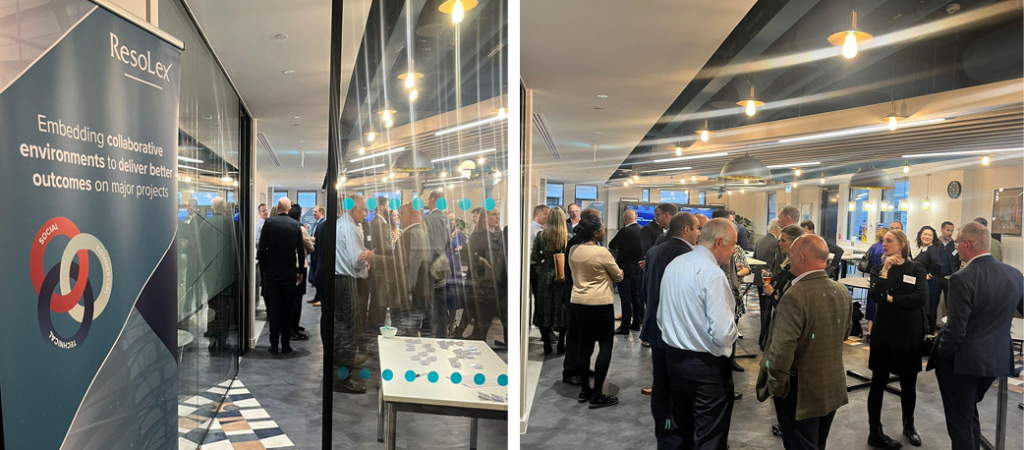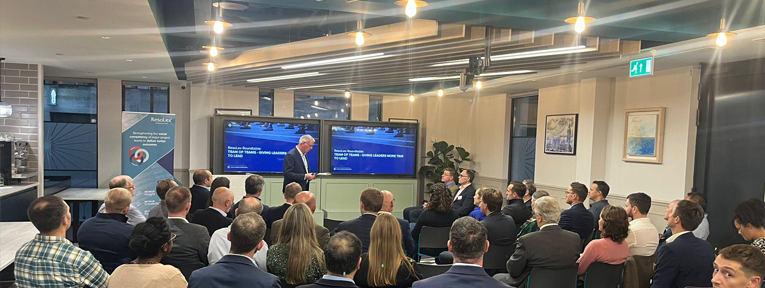On Tuesday 8th October, we hosted a roundtable discussion based on the Team of Teams (ToT) ethos, more commonly known from General Stanley McChrystal’s book Team of Teams: New Rules of Engagement for a Complex World. Published in 2015, the book refers to the concept ‘Team of Teams’, which aims to embed collaborative working across organisations through a web of interconnected teams, based on McChrystal’s experience as commander of the U.S. Joint Special Operations Command.
The purpose of the workshop was to explore the benefits of a Team of Teams approach within a commercial setting and some of the real lived experiences and challenges in managing its roll-out.
We were delighted to welcome two guest speakers:
- Simon Higgens MBE, Business Development Director at STORY Contracting and former Royal Engineer with the British Army
- Scott Murray, Performance and Integration Director at SCS Railways, delivering HS2 London Tunnels
Edward Moore, our Chief Executive, opened the session, providing background into our work and then into the book and its goals: principally around embedding an ethos of collaboration in organisations.
In addition, we shared a Slido poll to gauge the room’s experiences of cultural change in their projects and organisations before delving into the main content, this was later used as a comparison.

Simon opened with an example of his time in the military where he was given command and the goal of achieving a specific objective: Building a positive relationship with an ally.
He had freedom in the nature of the solution but a limited timeframe to design and implement his plan. Simon discussed how in his role he utilised a Team of Teams approach as a natural course of action to achieve results, despite at that point being unaware of the philosophy. He related the six key themes that underpinned his approach:
- Complex over complicated
When Simon first joined the military, it was focused on a hierarchical mindset: telling people what to do and how to do it. This meant that although tasks were complicated, there were clear plans. Over the years, growing complexity and asymmetrical warfare necessitated a shift to an output-based mindset: Focusing on embracing the complexity of a problem and how to achieve results with an adaptable approach over a fixed structure. This required a cultural change to collaboration being the norm – as it is the only way to achieve common aims.
- Unifying purpose
Every person involved in a project should be aware of what the ultimate goal is, understand why they are involved, and how their part relates to that purpose.
This enables teams and individuals to be empowered to make decisions that relate to their area, as they have a common and clear understanding of the ultimate goal.
- Effective delegation
Leaders need to step back and let teams ‘get on with it’. Teams should be built based on expertise, and therefore the team members are the ones who will know their work area and how best to approach tasks to deliver them successfully. Leaders need to be capable of driving strategy and longer-term thinking, managing high-level risks and scanning for upcoming issues.
Trust and communication are imperative for project success, and this must be modelled from the top.
- Adaptable over efficient
Every organisation needs to plan for change – it will happen regardless. Contingencies, mitigations and courses of action need to be thought through carefully as plans will inevitably change as a project progresses.
In addition, this adaptable approach should, again, be embedded as an active mindset in teams: people should be empowered to adapt and change things in the areas they have responsibility over, to serve the project goal.
- Leadership
Teams need to be allowed to grow, make mistakes and learn from them. A focus on ‘superhero leaders’ results in nobody else being taught how to lead, make decisions or develop to take on a responsibility. A spectrum of leadership skills is required, with a focus on understanding your team, their capabilities and skillsets.
Simon talked through how the military focuses on developing individuals’ skills for the next rank they’re aiming for, rather than putting underdeveloped people into roles they’re not yet ready for and hoping they succeed.
Throughout his talk, Simon stressed that the military, while sharing a lot of overlaps with commercial delivery, has a separate focus so not everything applicable in one area will be relevant to the other.
The project that he talked through in the session was ultimately successful, through a focus on the above themes enabling three key outcomes:
- Teams and individuals were allowed to lead in their areas: if they needed assistance, it was there, but he, as the overall leader, didn’t interfere in their specific areas.
- Building the environment for specialists to operate, taking away political interference and enabling them to focus on delivering.
- Leaders could focus on the long-term, strategic view over and above the minutiae of each task, trusting the team to deliver while they ensured objectives would be met.
Following on from Simon, Scott then talked through embedding Team of Teams in a contractual environment. Scott’s focus was on Team of Teams as a set of leadership behaviours that underpin how things are done. Scott imparted that moving to a Team of Teams approach is not a traditional organisational transformation, where boxes are moved around on an organisational chart, but instead represents a cultural change in how people within the organisation are expected to operate.

It also requires a shift in how people think: in implementing Team of Teams in a project organisation, Scott found that many discussions would turn to peoples’ concerns with their specific areas: If one of their SMEs was needed to support a different or more critical area of the business, how would that be budgeted? Would they get reimbursed for the time lost in their area of the project? There was a significant challenge in trying to embed a holistic, ‘best for project’ view over ‘best for me’.
Scott identified a number of key takeaways in implementing Team of Teams:
- Leadership needs to be bought in
Building a Team of Teams environment relies upon trusting people to deliver. This means that leaders need to get used to specifying outcomes over a list of tasks, which can be uncomfortable to those that like to maintain control.
Leaders need to support the embedding of new ways of working and not interfere. Importantly, they need to be focused on long-term thinking. Effective behavioural change across an organisation will not be done within 3 months, but more in the order of 2 years or more.
However, those two years will pass regardless: it is up to leaders whether at the end of it they have an effective, functioning environment or are still facing the same challenges.
- Bad behaviour needs to be dealt with immediately
This must happen from top to bottom. Leaders role model the behaviours that others will follow, so they must visibly demonstrate calling out and challenging behaviours that do not match the agreed or intended ways of working.
- Priority management
The environment you create to deliver your project is an important foundation for delivery. It underpins and supports every other part of the project. It should therefore be high on the agenda and consistently reinforced.
- Test and reinforce communications
To truly build understanding, individuals and teams need to be engaged and reengaged regularly and consistently. It is dangerous to assume understanding from one or two presentations or workshops, you must work with people and test that they understand why the new way of working is the right approach.

The floor was then opened up for discussion. In the following conversations, some themes shone through:
How do we break the cycle of making the same kinds of mistakes that we see so commonly across projects and programmes?
- As humans, we have many biases that inform recruitment, including affinity bias, where we recruit in our image. This is an area where we need to break the cycle to be able to diversify our approaches to delivering the best outcome.
- The right behaviours are just as important as technical competence and should be strongly considered in the hiring process, particularly for leadership roles – but following on from above, this needs to be properly designed so that “the right behaviours” are not simply “someone who thinks the same way as I do”!
- We need to have a system in the industry of training, educating and developing people to lead effectively. Graduate/apprentice schemes with 6-month placements are a good start, but after those initial 2-3 years nobody is ever again provided with this cross-industry experience.
- Change needs to be accepted and embedded as a constant over ‘business as usual’. We intrinsically know this to be true and many of us can resonate from experience: what was new 20 years ago is old and stale now. We need to set ourselves up to deliver in a changing environment rather than plan for change as an additional activity.
Is there a ‘critical mass’ of people required in a project organisation to embed the Team of Teams approach?
Team of Teams is more about a way of working, culture and behaviours, so should be applicable in any environment, from a small team to a whole army. However, the bigger the organisation, the more difficult it will be to embed. Leaders must be engaged: if they aren’t, it will fail. Scott suggested that if a proposal to utilise a Team of Teams approach doesn’t have active support from at least two-thirds of the leadership team, it may be better to scale back, focus on a smaller part of the organisation or project and make it work before attempting to go bigger.
The roundtable also highlighted some things that major projects and programmes in infrastructure can learn from other industries and areas, and the importance of considering behaviours and ways of working in project delivery.
A key theme that came out was the concept of “who is in your phone book?” – i.e., who do you contact when you need a problem resolved – and who do they contact? These are the people you want in your ‘team of teams’: the subject matter experts and problem solvers.
This needs to be tempered, however, by not just defaulting to the same people – this technique promotes using an existing network over either training new people or embracing diversity of thought.
The Slido poll also gave some positive results in that almost 75% of those present stated that their teams were enabled to make decisions and implement them, and the vast majority stating that they believed in long-term culture over short-term goals.
These are not new issues, extending back to the Latham Report in 1994 (and earlier!), however, the industry has historically struggled to come to terms with them. The collected experiences of the leaders and experienced professionals in the room show that perhaps there is a cultural change already underway that may support the long-term thinking and trusted, delegated decision-making that the industry needs to harness.
The roundtable posed some great insights into Team of Teams from the perspective of our speakers and guests, with great discussion had. We’d like to thank everyone who attended and encourage you to keep an eye out for next year’s programme of events. View our event calendar here.
